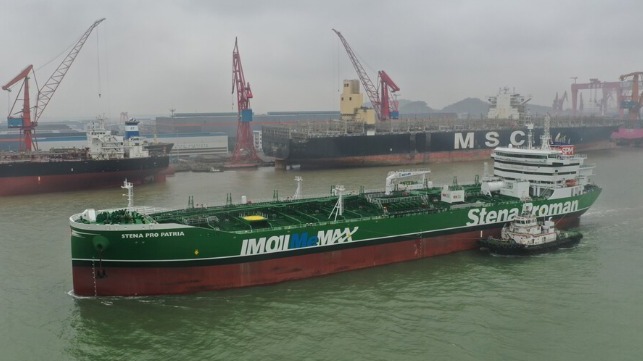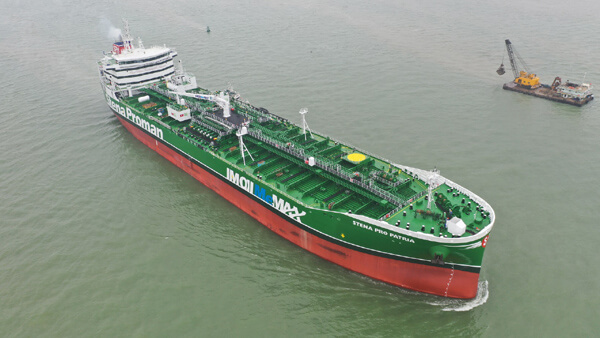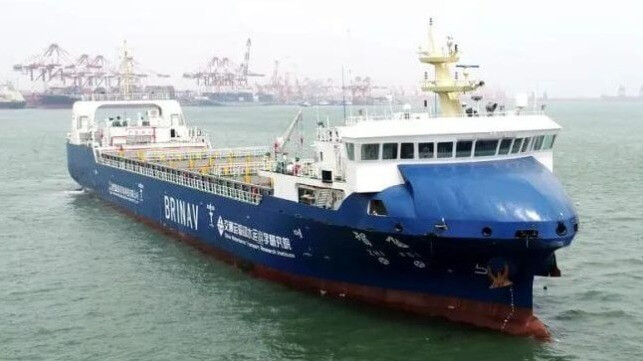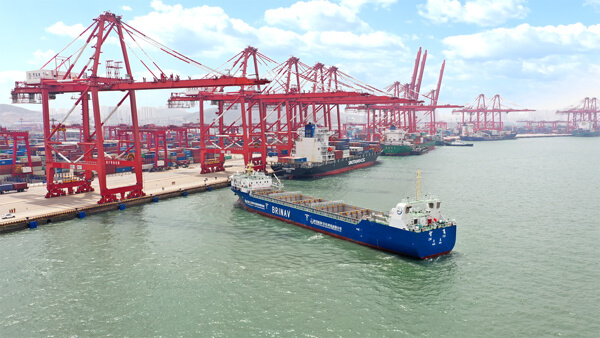First Chinese-Built Methanol-Fueled Tanker Begins Sea Trials

Sea trials recently began for the Stena Pro Patria, the first methanol-powered dual-fuel tanker constructed in China. Built by Guangzhou Shipyard International the vessel is the first of six 49,990 dual-fuel tankers designed to use methanol being built by the shipyard and are being billed as an advancement for methanol-fueled propulsion. Over the next few years, methanol is expected to expand rapidly as Maersk introduces the first large containerships designed to run on the alternative fuel and x-Press Feeders has ordered up to a dozen smaller containerships also operating on methanol.
Proman Stena Bulk, a joint venture between Sweden’s Stena Bulk AB and Switzerland’s Proman became the first of the new generation of shipping companies to order methanol-fueled vessels. Initially, they ordered two vessels and then expanded the order to three, while Proman later independently ordered three additional tankers all using the same design.
All the vessels are being built by Guangzhou Shipyard International (GSI) with the other two ships for Proman Stena Bulk also currently under construction. The Stena Pro Patria is expected to be delivered shortly, while her sister ships, Stena Pro Marine and Stena Prosperous, are also due to be completed this year. Each of the vessels will be 610 feet long with a 105 foot beam.

First methanol-fueled tanker is currently on sea trials with the first three vessels due to be delivered this year (GSI)
GSI vice president William Zhou hailed the start of sea trials and testing of the propulsion equipment as “a watershed moment” in the development of methanol as an alternative fuel for MR tankers. He said each tanker will significantly slash NOx emissions by using each year around 12,500 tons of methanol as a marine fuel. The vessels are powered by a MAN dual-fuel 6G50ME C9.6 engine, without catalyst conversion.
“We are very proud to see the first ship in this ground-breaking fleet begin sea trials,” said Zhou. “We won the contract under stiff competition from Korea and this ship shows what GSI is truly capable of building on our experience of building 30 dual-fuel vessels. The construction of the Stena Pro Patria is a massive achievement for all parties involved and I would like to thank Proman, Stena, our team, MAN engines as well as the class society DNV for all they are doing to make this bold ship design and fleet a reality.”
Zhou said each tanker uses the latest energy efficiency technology including continually controlled combustion, optimized tuning, redesigned and aerodynamic hull lines, and an energy shaft generator reducing fuel consumption.
“Methanol has the benefit of being widely available already near many ports worldwide having being shipped for decades,” said Zhou. “Moreover, bunkering of methanol, as an ambient temperature liquid fuel, is similar to distillate fuel so can be used in existing bunkering facilities with relatively few upgrades. He expects that the use of methanol will grow due to properties that make it no more dangerous than diesel and is less hazardous to the environment than diesel or HFO biodegrading rapidly in the event of a spill.
GSI highlighted that it has built, or is building, a total of 32 dual-fuel ships including two LNG propulsion ropax vessels, two LNG propulsion Suez tankers, 14 LNG propulsion LR2 tankers, eight LNG propulsion PCTCs, and six methanol propulsion MR tankers. Their goal is to become one of the world’s greenest shipyards.
China Launches its First Autonomous Container Ship Service

Chinese officials are reporting that they have put the world’s first autonomous, electric container feeder ship into commercial service after a period of extensive trials. The vessel, which was developed through a broad collaboration of Chinese institutions is reported to be a demonstration ship that will provide significant learning for the future development of the technology.
The vessel, named Zhi Fei (Chinese for Flying Wisdom) commenced its first regular voyage on April 22. The Zhi Fei is reported to be approximately 8,000 dwt with a capacity of 300 TEU. The vessel is 384 feet long with a beam of 57 feet and a depth of approximately 32 feet. Propulsion is reported to be by a DC electric system that gives the feeder ship a top speed of approximately 12 knots and a normal operating speed of 8 knots. The Zhi Fei was built by the Qingdao Shipyard.
The design for the vessel was led by Bestway in cooperation with Shanghai Jiahao Ship Design Institute and the Dalian Maritime University. The initial construction contract was signed at the end of 2019 with work beginning in May 2020. The vessel was launched in April 2021 with the first sea trials in June and testing on the systems began last September. The technical evaluation was completed in March 2022, and the vessel is now operating between Qingdao Port in Shandong Province and Dongjiakou managed by Navigation Brilliance (BRINAV).

Zhi Fei began commercial operations on April 22, 2022 (Bestway)
According to the reports, the ship adopts a full-rotation electric propulsion system based on hybrid technology and integrates large-capacity battery packs and generator sets through DC networking to achieve intelligent energy efficiency optimization. The Chinese are saying that it is the first time that a DC power system has been combined with intelligent operations.
The containership is capable of operating in three different modes, manned driving, remote driving, and unmanned driving. The intelligent systems provide independent route planning, intelligent collision avoidance, and remote-control operations. The vessel employs 5G, satellites, and other multi-network systems.
Information developed from this project and the operation of the ship are contributing to efforts to build similar self-propelled containerships with a larger capacity from 500 to 800 TEU.
No comments:
Post a Comment